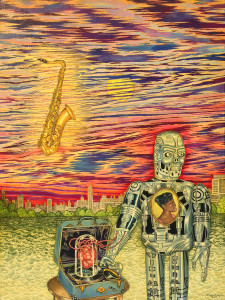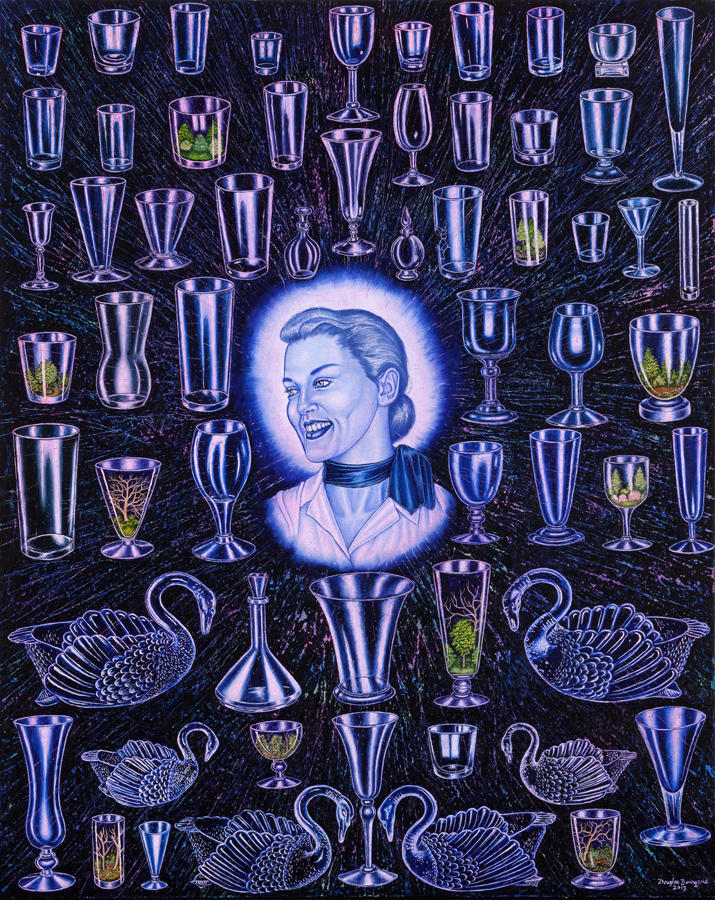
Douglas Bourgeois, 1951, Gonzales, LA
Lullabye, 2014.
About:
Bourgeois, who hails from the small town of St. Amant between New Orleans and Baton Rouge, is like a Renaissance church painter, striving to depict scenes of religious ecstasy. But Bourgeois’ saints and martyrs are secular music stars, from Irma Thomas to Bobby Womack to a young Danish diva named Coco O.
The Kitchen.
Coco O’s infectious dance tune called “Hey Love” is one of Bourgeois’ current favorites. That’s her, glancing coyly over her shoulder in Bourgeois’ 2013 painting “Double Holy Spirit Coco.” And those are a pair of Coco clones offering her spiritual support and solace from either side.
Bourgeois said that his father was the neighborhood sign painter, who used thick enamel to produce luxurious lettering in signs for church gatherings and auctions. As a kid, Bourgeois sometimes toyed with his dad’s brushes and paint. His lifelong love of dense shiny color comes through in his paintings, even though his brush strokes are sometimes as thin as eyelashes.
Alvis, 2008.
When Coco sings “Hey Love,” it sounds a lot like “halo,” which may be why Bourgeois chose to fill the sky above her with a glorious cloud of old-fashioned circular fluorescent light bulbs in pink, pale blue and white. He said he found the bulb image in the antique Sears catalog he calls his “visual bible.”
“I noticed those fluorescent fixtures, just the shape, that halo shape, like a UFO,” he said. “I still don’t know what that’s about; the luminosity of it. It’s a strange, mysterious object.”
Bourgeois came of age as an artist in the early 1980s. “Twilight High Yearbook” is one of his first breakout works. Compared to the minimalist and conceptual art experiments that had come before and the big, bold neo-expressionist painting trend that was making a splash in New York at the time, Bourgeois’ intimate narrative canvases seemed to be as far out as Pluto.
“I’d call them storytelling scenes,” he said of his paintings. “There are usually very few people, caught in a private moment or an awakening. People ask me what my style is. I say fairly realistic, but not really, like a dream.”
eyes-my-fill-that-tears, 2015.
Within a decade, his dreamy paintings had made him a regional hero.
Birds are timeless symbols of spirits, so Bourgeois released a flock of them into Coco’s triple portrait. Most perch on the cloud of light bulbs. But a pair of red-winged blackbirds plunge through hovering crowns of thorns, dripping blood and signifying the penetrating passion at the heart of most love songs. As Coco puts it: “Hey Love, what’s going on in here? You brutalize my soul.”
Everyone gets Bourgeois’ paintings. Everyone knows that sweet magical, sensation when music sweeps us up like fall leaves and allows us to fly. Bourgeois, maybe better than anyone else anywhere, is able to capture that feeling on canvas. A version of his Irma Thomas portrait became the 2008 New Orleans Jazz and heritage Festival poster.
Vessels, 2013.
“It’s the description of how a song can reach you,” he said of his Coco portrait. “There’s a spiritual element to it. It’s a transformational experience. You do think it’s otherworldly.”
“In paintings,” he said, “you can’t put the lightening in a bottle, but it’s the next best thing.” (text Doug MacCash in Times-Picayune, November 2014)
Courtesy: Arthur Roger Gallery New Orleans




